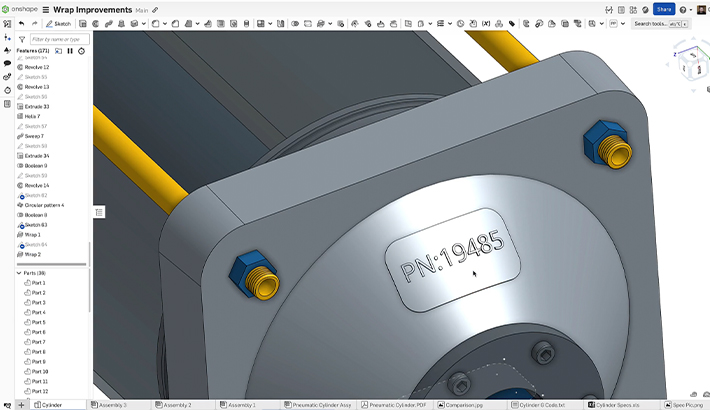SKIP TO SECTION:
- Considering SOLIDWORKS Alternatives
- Onshape as the SOLIDWORKS Alternative
- Tips for Streamlining the Transition to Onshape
At Onshape, we know a lot about SOLIDWORKS because (as many of you already know) all six of Onshape’s co-founders were early and influential builders at SOLIDWORKS.
So, it’s no surprise to us that a high percentage of the professional CAD users we talk to use SOLIDWORKS. Some are looking to switch over to a new system entirely, and some are looking to use a different software alongside their existing CAD system.
Along their journey, we’ve heard uncertainties they’ve faced just considering new software and then convincing leadership to jump on board. However, the challenge of transitioning away from SOLIDWORKS and implementing a new, better system shouldn’t be a deterrent – it should be the easy part if armed with best practices.
The hard part is at the beginning: Deciding to make a change for the better.
Considering SOLIDWORKS Alternatives
In today’s CAD market, there are plenty of options that come with different features and a range of price points. It all depends on the needs of the CAD user, their team, and their business.
What is the solution you’re looking for? Better collaboration tools? Less crashing? A better, more streamlined technology stack involving fewer software systems that barely communicate?
Many don’t fit the bill.
Some CAD systems can be used on-premise only and need powerful machines to work without constant crashes. Others have cloud capabilities but lack easy sharing access. Many tout features that promise so much but fail to deliver elsewhere.
While some CAD options can work for your team, many forward-thinking companies are switching from SOLIDWORKS to Onshape for the platform’s flexibility, scalability, and cloud-native architecture.
Onshape as the SOLIDWORKS Alternative
There are a lot of reasons why companies that are looking to replace or add to their current CAD system turn to Onshape. Onshape solves many issues associated with file-based, desktop-installed CAD. Here are a few reasons why:
Streamlined System: Onshape unifies CAD, PDM, and analytics in a cloud-native platform, eliminating inefficiencies, reducing development costs, and accelerating time-to-market. With streamlined collaboration, Onshape supports a distributed workforce, sharing real engineering information directly and instantly, and simultaneous design collaboration supports better designs that require less rework and waste. Finally, integration with third-party tools (PLM, ERP), API, and custom features through FeatureScript also allows collaboration extension.
Better ROI: With Onshape, there’s no installation (just sign-in), and new users can be added effortlessly, allowing your company to scale up. Data management is built-in, so there’s no extra cost for different software. Onshape can run on any device with an internet browser, meaning your team can save on expensive hardware. Since all design data is in the cloud, no servers are needed, lowering IT overhead. Plus, with added collaboration tools, workers along the product design line can be more productive and work on the stuff that matters most.
To explore the savings of Onshape, look at this online calculator.
Agile Product Development: Onshape enables real-time collaboration that drives agile workflows, which enable increased innovation, higher productivity, and improved quality by engaging the core team with extended internal teammates and external partners.
Easy CAD Data Migration: Onshape makes it easy to start designing as a team using legacy data. All you need are a few tips and tricks on how to best get this done.
Tips for Streamlining the Transition to Onshape
Dealing with files upon files of legacy data doesn’t have to be a massive headache – especially because Onshape is here to help! Here are a few tips on how to streamline the transition to Onshape.
Create a CAD Data Migration Timeline
The team will need to decide when to begin the transition and whether to switch all of the CAD data to Onshape, only some of it, or only start new projects in Onshape while holding on to legacy data elsewhere.
It’s also important to consider the timing of the transition to make sure it’s not in the way of any current work projects. However, the main lesson is to have a CAD data migration plan that fits the needs of the team’s plans and goals.
Also, there’s no such thing as an instant transition. Your business is in it to succeed in the long haul, and modern CAD will improve your processes to help you get there.
Develop a Design Data Migration Strategy
In the “10 Technical Questions When Moving from SOLIDWORKS to Onshape” webinar, Onshape’s Matt Rohr explains the ins and outs of starting in Onshape. The very first question from users is typically about transferring existing CAD data over to Onshape. Rohr offers a number of solutions.
Run Two Systems at Once: This is the “it’s not a light switch, it’s a dimmer” approach. It’s employed by larger, more mature companies but also works for younger companies that prefer to take a slower, more pragmatic approach to modern CAD. For minor revisions of old projects and supporting stable products that have shipped, it’s simple: Do those in SOLIDWORKS. Is it a new project? Is it one that’s going to take significant engineering time? Import the necessary existing data into Onshape and take advantage of the many benefits of cloud-native CAD.
Import Everything to Onshape and Translate on Demand: This is the equivalent of digitally scanning your entire archive of paper files. Whether this makes sense for your company depends on a couple of factors. The companies who choose this route are usually at an earlier stage when they don’t have a lot of legacy data to manage. You also might be taking this path because you feel your CAD provider is holding your upgrades hostage with a PDM upgrade you’re forced to pay for, whether you want it or not.
Use Onshape Partner Apps: CADSharp’s Monarch can save massive amounts of time migrating data into Onshape. The app helps users prevent duplicate files, maintains important metadata, and brings over non-CAD data, too.
Dive Into Onshape Training Resources
If you’re a seasoned user of professional CAD tools like SOLIDWORKS, Creo, Solid Edge, NX, CATIA, or Inventor, moving onto another CAD platform can take a little getting used to. From mouse buttons to assembly mates, every system does things slightly differently.
Onshape offers a bootcamp for new teams, along with plenty of resources in the Onshape Learning Center.
We've also collected all the information you need in one spot that will help smooth the transition from SOLIDWORKS to Onshape – but is relevant to every other CAD system, too. With a little practice, you’ll be flying with Onshape in no time and reaping the benefits you can only get from full-cloud CAD.
Ready to make the change?
The CAD
Migration Station
Find everything you need to know about
transitioning from SOLIDWORKS to Onshape.















